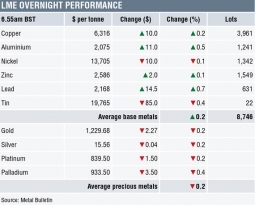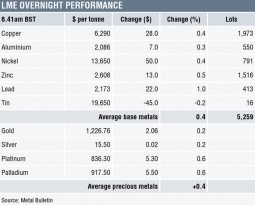Since the London Metal Exchange was bought by Hong Kong Exchanges & Clearing (HKEX) in 2012, it is safe to say that that the post-sale environment and progress has not been plain sailing – so 2017’s far-reaching consultation and Strategic Pathway has a lot riding on it.
Consultation exercises, not just in financial areas but also in general, can offer much on paper but actually deliver little. The LME in recent experience is not immune to such outcomes, with feedback, suggestions and wishes often acknowledged, but not really acted on.
This time around, deeds have followed words in many instances – co-operation has been the name of the game and welcome changes on fees are on the way.
The reaction to the LME discussion paper’s results has generally been positive, with a majority of the industry happy with the exchange’s actions – the discussion paper was launched in April this year to canvas opinion on the direction to take.
But in other areas there are still 500lb gorillas in the room, where unintended consequences may unfold – tick sizes related to systematic trading and screen versus end-of-day open outcry valuations spring to mind.
First things first, however: the upcoming fee changes, where the LME has listened, thought twice and changed tack.
Members, who have been particularly put out by high fees post-sale, have in many cases seen charges cut from the start of October below the levels that prevailed before HKEX came knocking. Astutely, the LME laid out fees pre-commercialisation to accentuate the point. Here, the User Committee played a part, perhaps more than they have done in previous exercises.
So, what will happen? Will there be a reversal in the declining trend in volumes – the business that may have gone elsewhere to venues such as CME and SHFE, the soon-to-be NFEx or even over-the-counter (OTC)? Will there be an upturn in LME turnovers enough to offset the potential fall in fee revenues?
It is possible that a variant of the Laffer Curve comes into play – the relationship between the level of tax and the amount of tax revenue raised, where the more an activity is taxed, the less revenue is generated.
Just substitute “fees” for “tax”, and lower LME contract fees may actually raise more revenue, as existing and, importantly, would-be participants opt to trade on what is still the world’s largest non-ferrous exchange, rather than rival exchanges or the bespoke OTC sector.
System traders
Leaving aside some grumbles about the possible introduction of OTC charges, fees are perhaps an easy win for the LME. In other areas, the exchange might find it akin to walking blindfold across a mine-field while wearing super-sized clown’s shoes. Take the impact of systems traders – it is worth looking again at the LME’s conclusions on systematic traders and what possible measures it may bring in.
“The LME understands the concerns raised around systematic financial traders, and believes that any technical approach to mitigate the impacts of speed must be carefully examined before any implementation, and should target specific problems caused by speed, rather than a broad-brush approach which could deter electronic traders.”
Fine words, and one of the specific problems related to LME contract tick-size and systematic traders being able to “jump in front” of other orders – the practice of placing orders one tick above or below an existing top-of-book order.
At present, the minimum tick-size is $0.50 for outrights and $0.01 for carries, which allows for very competitive and narrow “buy/sell” or “borrow/lend” quotations – very notable in outrights during the official price sessions and the closing valuations – today for example the official copper cash quote was $6,601.00/6,601.50 per tonne.
This impacts on screen-based quotes, which although not as tight, are still keenly-quoted to the benefit of customers and clients.
The LME is exploring widening the minimum tick-size, but needs to get the balance right – too wide will have a knock-on effect on the other platforms, which make up the bulk of the exchange’s volumes. Ever wider “buy/sell” rates on screens, which may result, are not beneficial for customers.
And then there is the experiment of testing 5pm closing settlement prices away from the floor on LME Select, instead – some participants express frustration that they cannot trade on screen and get the settled closing price.
The easy answer is to say become a category I dealer, but that particular horse bolted a long time ago because of the high level of underlying costs, mostly personnel-based, that stem from open-outcry participation.
So, from next year the exchange will try settling some of the metals via LME Select, while other metals will remain settled via the traditional ring. The LME hopes this will lead to more participants contributing to settlement prices.
It is a worthwhile experiment – nothing should stay the same forever. But beware unintended consequences for open-outcry trading as a whole. Those with long memories will remember the LIFFE (London International Financial Futures Exchange) and its many thriving pits. In the late-1980s its most active contract was German Bund Futures, which regularly traded over 70,000 lots daily.
The then-German bourse – the DTB – brought in an electronic version of Bund Futures, and market participants swiftly voted with their feet, or in this case, their fingers. Within three months LIFFE Bund turnover had fallen to an average 300 lots per day. Other LIFFE contracts eventually went the same way.
On the LME, the 16:30-17:00 period is the most active and vibrant part of the open-outcry day. It is for the nine ring-dealers perhaps the most profitable part of the day. Any dilution of this could make staying a ring-dealer harder to justify.
However, this, and tick-sizes, as well as OTC fees, are cans that have been placed down the road. For now, there are more positives than negatives in the Strategic Pathway.
Nothing is certain in this Brexit, Trumpian, North Korean world now. But the chances are that twelve months from now the LME will have regained much of its standing with members, its various users, the metals industry and observers.
The post COMMENT: Strategic Pathway – what next for the LME after the Town Hall appeared first on The Bullion Desk.
Read More
Source: Bullion Desk News








